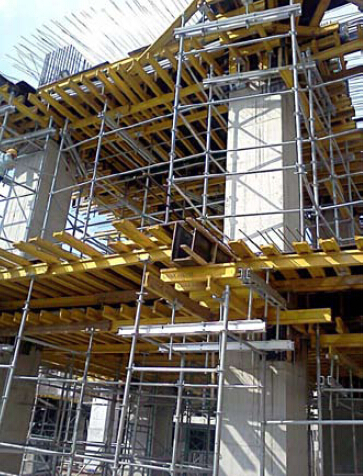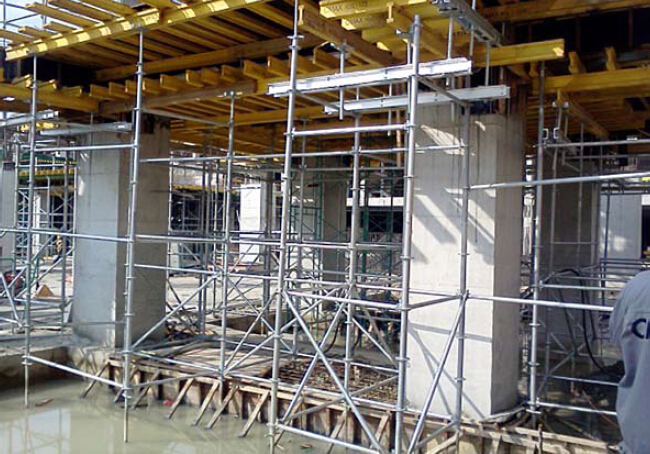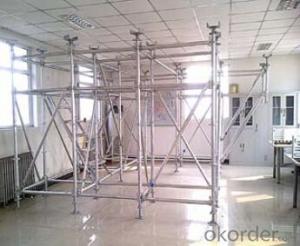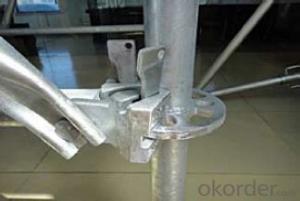Ring-lock Scaffolding Accessories for Formwork and Scaffolding System
- Loading Port:
- Tianjin
- Payment Terms:
- TT OR LC
- Min Order Qty:
- 50 m²
- Supply Capability:
- 1000 m²/month
OKorder Service Pledge
Quality Product, Order Online Tracking, Timely Delivery
OKorder Financial Service
Credit Rating, Credit Services, Credit Purchasing
You Might Also Like
Ring-lock Scaffolding
A support system for construction, ownsadvantages of both cup-lock scaffolding andshoring tower.
It is in the development direction of new typescaffolding.
It is widely used in buildings, bridges, tunnels etc..
Characteristics:
◆ Easy to storage and transportation
◆ High degree of standardization
◆ Easy and quick erection
◆ Excellent stability and bearing capacity


- Q: What are the common design considerations for steel formwork systems?
- Some common design considerations for steel formwork systems include the load capacity of the system, the stability and rigidity of the forms, the ease of assembly and disassembly, the ability to accommodate various concrete shapes and sizes, the durability and longevity of the materials, and the compatibility with other construction methods or systems. Additionally, factors such as cost, availability, and environmental impact may also be taken into account when choosing a steel formwork system.
- Q: How does steel formwork affect the overall construction site safety?
- Construction sites widely utilize steel formwork due to its strength, durability, and reusability, which play a crucial role in enhancing safety measures. The secure and stable structure provided by steel formwork during concrete pouring minimizes the risk of collapse or failure, thereby reducing the likelihood of accidents like falls. Additionally, the ability of steel formwork to withstand high pressures exerted by wet concrete ensures the desired shape and structure of the concrete, reducing the risk of structural defects or weaknesses. The easy assembly and disassembly of steel formwork facilitate efficient installation and removal, minimizing the time spent on the construction site and exposure to potential hazards. Customizability and tailoring of steel formwork ensure precise concrete placement, minimizing the need for rework and preventing accidents or injuries arising from incorrect placements. Furthermore, the reusability of steel formwork reduces waste and the associated risks of tripping hazards or material obstructions on the site, creating a safer working environment. Overall, steel formwork significantly enhances construction site safety by providing stability, preventing structural defects, reducing construction time, enabling precise placements, and minimizing waste. Its robust and reliable nature ensures a secure working environment and reduces potential risks and hazards.
- Q: How does steel formwork affect the overall cost of a construction project?
- The overall cost of a construction project can be significantly affected by steel formwork. Although the initial expense of steel formwork may be greater than other formwork options, it offers multiple advantages that can result in long-term cost savings. To begin with, steel formwork is highly durable and can be reused, making it a cost-effective choice for multiple construction projects. Unlike wood and other formwork materials, steel does not warp or degrade over time, reducing the need for expensive replacements or repairs. Furthermore, steel formwork provides enhanced structural stability, ensuring accurate and precise placement of concrete. This leads to decreased material wastage and a more efficient use of resources, ultimately reducing construction costs. In addition, steel formwork offers faster assembly and disassembly times compared to traditional formwork materials. The quick installation and removal process can significantly decrease labor costs and the overall duration of the project, resulting in increased productivity and potential savings on overhead expenses. Moreover, steel formwork is highly adaptable and can be customized to meet different project requirements. Its versatility allows for its use in various construction applications, such as forming complex shapes and designs. This flexibility reduces the need for expensive specialized formwork systems and enables cost-effective solutions tailored to specific project needs. Lastly, steel formwork is renowned for its excellent quality and precision, resulting in higher-quality concrete finishes. This can eliminate the need for additional finishing work, such as plastering or leveling, which can be expensive and time-consuming. In conclusion, while the initial cost of steel formwork may be higher than alternative materials, its durability, structural stability, faster assembly times, adaptability, and high-quality finishes can lead to significant cost savings throughout the construction project. Therefore, considering the long-term benefits and cost-effectiveness of steel formwork is crucial when evaluating the overall cost of a construction project.
- Q: Does steel formwork require special equipment for installation?
- Special equipment is necessary for the installation of steel formwork. Unlike traditional wooden or plastic formwork, steel formwork is heavier and stiffer, necessitating stronger and more specialized equipment for handling and installation. Cranes, forklifts, and hoists are commonly used to lift and position the steel panels and beams during installation. In addition, specific tools like clamps, braces, and connectors are required to secure the formwork system and maintain its stability while pouring concrete. The utilization of this specialized equipment not only simplifies the installation process but also guarantees the safety and stability of the formwork structure.
- Q: How does steel formwork contribute to the overall sustainability of the project?
- There are several ways in which steel formwork contributes to the overall sustainability of a project. Firstly, steel is an incredibly durable material that can withstand heavy loads and repeated use. This means that the same steel formwork can be used for multiple construction cycles, reducing the need for new formwork materials and minimizing waste. Moreover, steel formwork is highly adaptable and can easily be customized to meet various design requirements. This flexibility allows for efficient material usage and reduces the amount of construction waste generated. Furthermore, steel formwork is highly recyclable. When it reaches the end of its life cycle, it can be easily taken apart and recycled. This reduces the demand for new steel production and minimizes the environmental impact associated with mining and manufacturing new materials. Additionally, compared to traditional timber formwork, steel formwork offers better quality control. It provides precise and consistent dimensions, resulting in a final product of high accuracy and quality. This reduces the need for rework and ensures less material wastage. Lastly, the use of steel formwork can lead to shorter construction periods. Its quick assembly and disassembly allow for faster construction processes, reducing the overall energy consumption and carbon emissions associated with the project. To conclude, steel formwork contributes to the overall sustainability of a project through its durability, recyclability, versatility, and efficiency. By reducing waste, minimizing environmental impact, and improving construction processes, steel formwork helps create more sustainable and environmentally-friendly construction projects.
- Q: How does steel formwork handle surface imperfections in concrete?
- Steel formwork is a rigid and durable material that is able to handle surface imperfections in concrete effectively. Its strength and stability allow it to support the weight of wet concrete, preventing any deformation or distortion caused by uneven surfaces. Additionally, steel formwork provides a smooth and uniform surface, minimizing any irregularities or blemishes that may occur during the pouring and curing process of concrete. Overall, steel formwork offers excellent resistance to surface imperfections, resulting in high-quality and aesthetically pleasing concrete finishes.
- Q: Can steel formwork be used for precast concrete stairs?
- Yes, steel formwork can be used for precast concrete stairs. Steel formwork is a suitable choice for constructing precast concrete stairs due to its durability, strength, and ability to create complex shapes. It provides a strong and stable mold for pouring and shaping the concrete, resulting in high-quality and precise precast concrete stairs.
- Q: How does steel formwork accommodate for different concrete pouring rates?
- Steel formwork is a versatile construction material that can easily accommodate different concrete pouring rates. The adjustable nature of steel formwork allows for quick and efficient adjustments to be made to match the required pouring rate. One way steel formwork accommodates for different pouring rates is through its modular and customizable design. Steel formwork can be easily assembled and disassembled, allowing for the construction of any desired shape or size. This flexibility enables construction teams to adjust the formwork to accommodate different pouring rates as needed. For example, if a higher pouring rate is required, additional formwork panels can be added to increase the capacity and ensure the concrete can be poured at a faster pace. Moreover, steel formwork is known for its robustness and strength. This means that it can withstand the pressure exerted by the concrete during pouring, regardless of the pouring rate. The sturdiness of steel formwork prevents any deformation or collapse, ensuring the concrete is properly contained and shaped according to the desired structure. Additionally, steel formwork offers excellent reusability, allowing it to be used for multiple construction projects. This reusability factor makes it a cost-effective choice, as the initial investment in steel formwork can be easily recovered over time. Consequently, construction teams can adapt the formwork to different pouring rates without incurring significant additional expenses. In conclusion, steel formwork is a highly adaptable construction material that can easily accommodate different concrete pouring rates. Its modular design, strength, and reusability make it a preferred choice in construction projects where pouring rates may vary. With steel formwork, construction teams have the flexibility to adjust the formwork to match the required pouring rate, ensuring a smooth and efficient concrete pouring process.
- Q: How does steel formwork contribute to faster construction?
- There are several ways in which steel formwork speeds up construction. Firstly, steel formwork is exceptionally durable and can endure multiple uses. This means it can be reused on various construction projects, reducing the need to constantly manufacture new formwork. This not only saves time but also cuts costs associated with buying new materials for each project. Moreover, steel formwork is quick and simple to assemble and disassemble. The modular nature of steel formwork allows for efficient installation and removal, enabling construction teams to complete projects at a faster pace. This is particularly advantageous for projects with tight schedules or where speed is crucial. Furthermore, steel formwork provides a smooth and consistent surface finish, eliminating the need for additional plastering or finishing work. This saves time and effort during the construction process, as there is no need to wait for plaster or other finishing materials to dry before moving on to the next stage. Additionally, steel formwork offers greater design flexibility. Steel can be easily fabricated into various shapes and sizes, allowing for the construction of complex structures. This versatility eliminates the need for expensive and time-consuming custom formwork solutions, as steel formwork can be adapted to meet the specific requirements of each project. Lastly, steel formwork is renowned for its excellent strength and stability. It can withstand heavy loads and adverse weather conditions, ensuring the safety and stability of the construction site. This reduces the risk of delays due to structural issues or the need for additional reinforcements, allowing the construction process to progress smoothly and efficiently. Overall, the use of steel formwork in construction projects speeds up construction by providing durability, easy assembly and disassembly, a smooth surface finish, design flexibility, and enhanced strength and stability. These factors combined help to streamline the construction process and reduce the overall project timeline.
- Q: How does steel formwork handle different concrete curing time requirements?
- Steel formwork is a versatile and durable option for construction projects, including concrete structures. When it comes to handling different concrete curing time requirements, steel formwork offers several advantages. Firstly, steel formwork provides a robust and stable framework for the concrete to be poured into. This ensures that the concrete is held in place and maintains its desired shape during the curing process. Regardless of the required curing time, steel formwork can effectively support the weight and pressure exerted by the concrete, preventing any deformation or collapse. Moreover, steel formwork is highly adjustable and customizable. It can be easily modified to accommodate different curing time requirements. For instance, if a particular section of concrete requires a longer curing time, additional support can be added to the steel formwork to provide extra strength and stability. On the other hand, if a section requires a shorter curing time, the steel formwork can be adjusted accordingly to facilitate quicker curing. Additionally, steel formwork has excellent heat conductivity properties. This allows for efficient heat dissipation during the concrete curing process. Different concrete mixes may have varying heat generation rates during hydration, and steel formwork aids in maintaining uniform curing temperatures. This is particularly beneficial when dealing with concrete structures that have specific curing temperature requirements. Furthermore, steel formwork is reusable and can withstand multiple casting cycles. This means that it can be used for different projects with varying concrete curing time requirements, making it a cost-effective option. The durability and strength of steel formwork ensure its longevity, enabling contractors to adapt to different curing time requirements without the need for constant replacement. In conclusion, steel formwork is well-suited to handle different concrete curing time requirements. Its stability, adjustability, heat conductivity, and reusability make it an ideal choice for construction projects of various scales and complexities. Whether the concrete requires a longer or shorter curing time, steel formwork provides the necessary support and flexibility to ensure successful curing and the creation of strong and durable concrete structures.
Send your message to us
Ring-lock Scaffolding Accessories for Formwork and Scaffolding System
- Loading Port:
- Tianjin
- Payment Terms:
- TT OR LC
- Min Order Qty:
- 50 m²
- Supply Capability:
- 1000 m²/month
OKorder Service Pledge
Quality Product, Order Online Tracking, Timely Delivery
OKorder Financial Service
Credit Rating, Credit Services, Credit Purchasing
Similar products
Hot products
Hot Searches
Related keywords




















